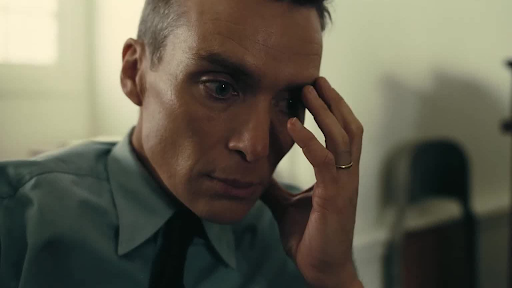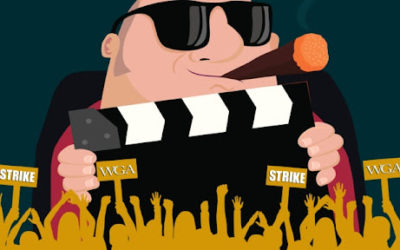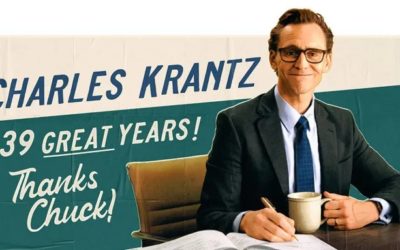Source: IMDb
Although anything is possible and there is always room for a potential upset, many would agree that the film most likely to win the Best Picture prize at the upcoming 96th Academy Awards ceremony is Christopher Nolan’s epic biographical drama “Oppenheimer”. Should this outcome occur as many are expecting it to, it will be quite noteworthy for a variety of reasons. For one thing, it will finally earn Nolan his first ever Best Picture win (and likely an accolade for Best Director as well); despite a filmography consisting of such critically acclaimed features as “The Dark Knight”, “Inception”, and “Dunkirk”, none of them have yet proven fortunate enough to win the Academy of Motion Picture Arts and Sciences’ highest honor (despite each of them still picking up quite a few awards here and there). To many, “Oppenheimer” winning Best Picture would be seen as the Academy finally acknowledging Nolan’s status as a modern master of the cinematic medium. However, a win for “Oppenheimer” would also stand out due to the film’s unusually high box office gross, as the film recently wrapped up its initial box office run with a total of $329.1 million in North America and $631.6 million overseas, amounting to an overall worldwide total of around $960.7 million. Even if it wasn’t able to cross the billion dollar mark, this is still an unprecedented achievement, especially considering how the Academy doesn’t always favor films that earn so much money.
If one were to look back at many of the previous Best Picture winners, one would find that most of these films are usually not the kind that would generate record-breaking numbers at the box office. For comparison, the last film to be named Best Picture by the Academy, Daniel Kwan and Daniel Scheinert’s “Everything Everywhere All at Once”, was able to pull in $77.2 million domestically and $66.2 million overseas (a global total of $143.4 million). That’s certainly an impressive accomplishment given the films $14-25 million budget, and the film’s ability to endure within the top 10 during its theatrical release speaks to the highly positive word-of-mouth the film received, but even that amount is but a fraction of what “Oppenheimer” was able to take in. More importantly though, “Everything Everywhere All at Once” is one of the higher-grossing Best Picture winners of recent memory, with many of the Best Picture winners preceding it earning significantly less in terms of box office revenue.
None of this, of course, is to say that the Academy completely ignores films that make substantial amounts of money at the box office. After all, “Barbie”, the highest-grossing film of 2023, will be competing for Best Picture alongside “Oppenheimer”, and just last year, “Avatar: The Way of Water” and “Top Gun: Maverick”, the two highest-grossing films of 2022, were also Best Picture nominees at the previous Academy Awards. Neither film won, however, and should “Oppenheimer” triumph as many are anticipating, “Barbie” will probably be denied a Best Picture trophy. With all of this in mind, it may seem easy to assume that the films that the Academy thinks are worthy of winning Best Picture and the films that make hundreds of millions, if not billions, of dollars at the box office are one and the same. If one were to look back at the Academy’s history though, one may be surprised to find that there have been several instances where major box office popularity and a Best Picture win were both bestowed onto a specific film from time to time. Such instances may be few and far between, but they do prove that the Academy is sometimes willing to admit that the biggest box office blockbusters are the films that most deserve to be named Best Picture.
One thing to keep in mind, however, is that theater ticket prices have not been consistently stagnant, as inflation has caused the average cost to grow significantly over the past several decades. Because of this, it may be more beneficial to analyze how many tickets a film was able to sell rather than the amount of money it was able to receive, as the former is a much stronger indicator of how popular a film is at the time of its release. After all, if two films – one released in 2003, the other in 2023 – were to each make a billion dollars, the earlier-released one would be the more popular of the two due to ticket prices being lower than they would be twenty years later. With all that said, here are the highest grossing Best Picture winners at the North American box office (adjusted for inflation):
- Gone with the Wind (1939) – roughly 202,286,200 tickets for an adjusted total of $1,895,421,694
- The Sound of Music (1965) – roughly 142,485,200 tickets for an adjusted total of $1,335,086,324
- Titanic (1997) – roughly 135,549,800 tickets for an adjusted total of $1,270,101,626
- Ben-Hur (1959) – roughly 98,046,900 tickets for an adjusted total of $918,699,453
- The Sting (1973) – roughly 89,142,900 tickets for an adjusted total of $835,268,973
- The Godfather (1972) – roughly 79,056,084 tickets for an adjusted total of $739,503,825
- Forrest Gump (1994) – roughly 78,637,100 tickets for an adjusted total of $736,829,627
- Around the World in 80 Days (1956) – roughly 64,615,400 tickets for an adjusted total of $605,446,298
- The Lord of the Rings: The Return of the King (2003) – roughly 61,639,700 tickets for an adjusted total of $577,563,989
- My Fair Lady (1964) – roughly 60,062,200 tickets for an adjusted total of $562,782,814
- The Greatest Show on Earth (1952) – roughly 60,000,000 tickets for an adjusted total of $562,000,000
- West Side Story (1961) – roughly 56,012,900 tickets for an adjusted total of $524,839,936
- Lawrence of Arabia (1962) – roughly 55,437,000 tickets for an adjusted total of $519,444,690
- Rocky (1976) – roughly 55,040,000 tickets for an adjusted total of $515,724,800
- The Best Years of Our Lives (1946) – roughly 55,000,000 tickets for an adjusted total of $515,350,000
- The Bridge on the River Kwai (1957) – roughly 54,400,000 tickets for an adjusted total of $509,728,000
- One Flew Over the Cuckoo’s Nest (1975) – roughly 53,685,400 tickets for an adjusted total of $503,032,198
- Dances with Wolves (1990) – roughly 43,699,300 tickets for an adjusted total of $409,462,441
- Rain Man (1988) – roughly 43,291,700 tickets for an adjusted total of $405,475,506
- Kramer vs. Kramer (1979) – roughly 43,020,200 tickets for an adjusted total of $403,099,274
- Patton (1970) – roughly 39,838,600 tickets for an adjusted total of $373,287,682
- Platoon (1986) – roughly 35,436,000 tickets for an adjusted total of $332,035,320
- Gladiator (2000) – roughly 34,814,000 tickets for an adjusted total of $326,207,180
- Terms of Endearment (1983) – roughly 32,878,000 tickets for an adjusted total of $308,071,545
- Midnight Cowboy (1969) – roughly 31,538,800 tickets for an adjusted total of $295,518,556
- The French Connection (1971) – roughly 31,333,300 tickets for an adjusted total of $293,593,021
- The Silence of the Lambs (1991) – roughly 31,055,300 tickets for an adjusted total of $290,988,161
- A Beautiful Mind (2001) – roughly 29,414,700 tickets for an adjusted total of $275,615,739
- Chicago (2002) – roughly 28,306,400 tickets for an adjusted total of $265,230,968
- The Godfather Part II (1974) – roughly 25,455,100 tickets for an adjusted total of $238,514,287
- Driving Miss Daisy (1989) – roughly 25,214,100 tickets for an adjusted total of $236,256,117
- American Beauty (1999) – roughly 24,935,000 tickets for an adjusted total of $233,585,667
- Unforgiven (1992) – roughly 24,390,500 tickets for an adjusted total of $228,538,985
- Out of Africa (1985) – roughly 23,562,400 tickets for an adjusted total of $220,779,854
- Schindler’s List (1993) – roughly 23,085,000 tickets for an adjusted total of $216,306,450
- The Deer Hunter (1978) – roughly 20,931,300 tickets for an adjusted total of $196,126,281
- Ordinary People (1980) – roughly 20,359,500 tickets for an adjusted total of $190,768,515
- The Departed (2006) – roughly 20,120,800 tickets for an adjusted total of $188,531,896
- Chariots of Fire (1981) – roughly 20,060,900 tickets for an adjusted total of $187,970,633
- Shakespeare in Love (1998) – roughly 19,833,700 tickets for an adjusted total of $185,841,769
- Slumdog Millionaire (2008) – roughly 19,017,700 tickets for an adjusted total of $178,245,510
- The King’s Speech (2010) – roughly 17,612,000 tickets for an adjusted total of $165,024,440
- Braveheart (1995) – roughly 17,350,300 tickets for an adjusted total of $162,835,608
- The English Patient (1996) – roughly 17,309,200 tickets for an adjusted total of $162,187,204
- Annie Hall (1977) – roughly 17,153,100 tickets for an adjusted total of $160,724,547
- Argo (2012) – roughly 16,943,900 tickets for an adjusted total of $158,764,343
- Gandhi (1982) – roughly 16,758,200 tickets for an adjusted total of $157,024,334
- Million Dollar Baby (2004) – roughly 15,681,300 tickets for an adjusted total of $146,933,781
Source: Box Office Mojo
So what can be learned from all of this information? For one thing, the assumption that the Academy doesn’t favor films that make large amounts of money at the box office isn’t entirely accurate; all of the films listed above rank somewhere in the top 1,000 highest-grossing North American box office releases (adjusted for inflation), selling at least 15 million tickets each and generating a gross that would amount to at least $145 million if each ticket costed as much then as it does now. Granted, many of these films saw their grosses increase AFTER they were nominated for Best Picture (and perhaps more so after they won), but either way, it does prove how the Academy Awards can influence a film’s box office gross just as much as the inverse is true.
Of course, even when a film is able to receive a box office boost via a Best Picture win, these numbers also show how much audiences and studios have become less enthralled with the kinds of films that tend to win Best Picture in favor of more conventional blockbuster fare. Many of the more popular Best Picture winners, as the list above proves, were released between the 1950s and the 1980s, with the newest film on the list, 2012’s “Argo”, only making it to #46, whereas the oldest film on the list, 1939’s “Gone with the Wind”, sits comfortably at the top of the list and will likely not be dethroned any time soon. It’s quite telling that, should it be the next film to win Best Picture at the Academy Awards, “Oppenheimer” would only barely usurp “Gladiator” for the #23 spot despite being the most successful of such films to be released in over a decade. Then again, perhaps the warm reception from both awards voters and audiences may prove beneficial to more than just “Oppenheimer”; if studios are willing to recognize that they can make films that can cater to both groups, then it’s quite possible that another film that grosses just as much as Nolan’s film may go on to become a future Best Picture recipient.




